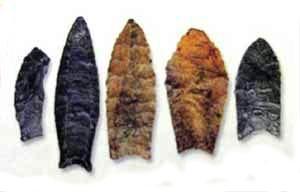Anthropologists speculate that south Oregon's "Western stemmed" culture could have been here prior to the Clovis.
Daniel Jack Chasan
Source - http://crosscut.com/2012/07/30/tribes/109728/mazama-earliest-american-clovis-science-oregon-cha/

Travis S./Flickr - Paisley Caves are between Albert Lake, above, and Summer Lake in Oregon.

Exeter Mogs - poop. It's how we study our forefathers from 10,000 B.C.

Wikimedia Commons - Clovis spear points
We don't know who they were, but we know they were here before 10,000 B.C. They hunted camels in the lush grass of southern Oregon. They probably saw 12,000-foot Mount Mazama looming over the western horizon.
They lived here as early as members of the Clovis culture, named after a style of fluted stone projectile point first found around the start of the Great Depression near Clovis, New Mexico. Roswell, New Mexico, has its UFOs, and Clovis has its stone-age mammoth hunters. So do a lot of other places. By now, Clovis points have been found all over the continent, including East Wenatchee. For decades, archaeologists repeated the mantra "Clovis first." In other words, they assumed that the people who made those fluted points were the first human beings in the Americas.
But evidence has been mounting for years that Clovis wasn't first, that other people were here just as soon if not sooner. Some of the most compelling evidence has come from south-central Oregon's Paisley Caves. Until recently, though, some scientists raised legitimate questions about the dating of objects found at Paisley. This month, those questions were presumably laid to rest.
The precise dating of Western stemmed stone weapon points and accompanying coprolites — i.e., mummified turds — found in the Paisley Caves has received a lot of press. "Stone Tools Hint at Previously Unknown Ancient Culture in North America," proclaimed one headline.
"Archaeological work in Oregon's Paisley Caves has found evidence that Western Stemmed projectile points — darts or thrusting spearheads — were present at least 13,200 years ago during or before the Clovis culture in western North America," said Science News. The magazine explained that the "radiocarbon dating of the Western Stemmed projectiles to potentially pre-Clovis times . . . provides new information in the decades-old debate that the two point-production technologies overlapped in time and may have developed separately. It suggests that Clovis may have arisen in the Southeastern United States and moved west, while the Western Stemmed tradition began, perhaps earlier, in the West and moved east."
All this attention was stirred up by a paper that Dennis L Jenkins, a senior research associate at the University of Oregon's Museum of Natural and Cultural History, and many colleagues published in the July 13 issue of Science. The authors explained that "Western Stemmed projectile points were recovered in deposits dated to 11,070 to 11,340 (carbon 14-dated) years ago, a time contemporaneous with or preceding the Clovis technology. There is no evidence of diagnostic Clovis technology at the site. These two distinct technologies were parallel developments, not the product of a unilinear technological evolution.
This is stuff that Jenkins, who has been working at the Paisley Caves for years, figured out long ago. Coprolites that he found in 2002 and 2003 produced what seemed to be the oldest human DNA in the Americas, pre-dating Clovis.
But when Jenkins and colleagues published a paper inScience four years ago, other scientists raised questions about their findings. The dates had been startling, and the outside scientists wondered, among other things, if maybe the layers in the cave had been churned up. Or, they speculated, water might have leached newer DNA down to older layers so that the context made the coprolites seem older than they really were.
Jenkins' new paper addressed those questions. As he and his colleagues wrote in Science: "'Blind testing' analysis of coprolites by an independent laboratory confirms the presence of human DNA in specimens of pre-Clovis age." Shortly after the new Science article appeared, Jenkins said he thought that the 190 repetitions of carbon dating on which the article was based should satisfy the skeptics.
So who were these Western stemmed guys? No one really knows.
Jenkins said the DNA hasn't been analyzed enough to identify groups with common ancestors, but not enough to pinpoint the toolmakers' origins. Eventually, perhaps, we'll know exactly where they came from. But, Jenkins explained, doing a full analysis will be very expensive, and no one has paid for it yet.
The stemmed points may be more robust versions of the delicate points found on California's Channel Islands, which were made by people who coexisted with Clovis and who may have come around the North Pacific rim from the Kuril Islands, strung between the northern tip of Hokkaido and the tip of the Kamchatka Peninsula.
That is a theory put forth by University of Oregon archaeologist Jon Erlandson, who was a leader of the research project that dated the Channel Island points. Erlandson figures that the Channel Island people followed the coastline in boats. Perhaps, he speculates, when they reached the isthmus of Panama, some made their way north to the southeastern United States, where they developed the Clovis technology.
Whoever brought stemmed points to the Americas, their culture proved more durable than Clovis, which disappeared after only a few hundred years. Stemmed point "technology went on for a ... long time," Jenkins explains. "Conceivably (Western stemmed technology) was present before Clovis, and then it continued until about 9,000 years ago." At that time, "it changed to notch points."
Bottom line: Just because someone finds stemmed points doesn't mean he or she has found something pre-Clovis. A person needs to find them in a context that proves their age. After all the carbon dating, Jenkins and his colleagues are sure they've done so at Paisley.
What they've found are small points made of obsidian. In fact, "about 90 percent of all the artifacts [found in the caves at the earliest level of human habitation] are made of obsidian," Jenkins said.
The Paisley Caves are on Bureau of Land Management land near Summer Lake, a couple of hours' drive southeast of Bend. Jenkins said the site is "visible if you know what you're looking for from Highway 31." Tucker Hill is an obsidian source about 17 miles south of Paisley, although Jenkins said the stone is "nearly ubiquitous" in the area.
The small size of the points suggests darts, which is to say short spears thrown — very hard — with atlatls (spear throwers that increase the leverage of the human arm). "Darts used with an atlatl tend to be about four feet" long," Jenkins said.
The area is a treeless landscape. So what did the dart-makers use for wood?
Jenkins said that he and his colleagues have been "finding fragments of willow that appear to be about a centimeter in diameter. That would be a very nice dart size." But willows like wet places. Where would they have grown?
"The willow would certainly have been available right down there in the basin," he said. There would have been plenty of riverbank and lakeside marshes.
The climate would have been cooler and damper than it is now. As for the landscape, "I anticipate it was a mosaic," Jenkins said. "Today the site is just surrounded by sagebrush, bitter brush . . . At the end of the Pleistocene, we're finding evidence for trees like juniper, ponderosa pine. There was manzanita, service berry." In addition, "grasslands would have been more extensive," providing food for the camels, horses and bison that the Paisley Caves people evidently killed with their stemmed points.